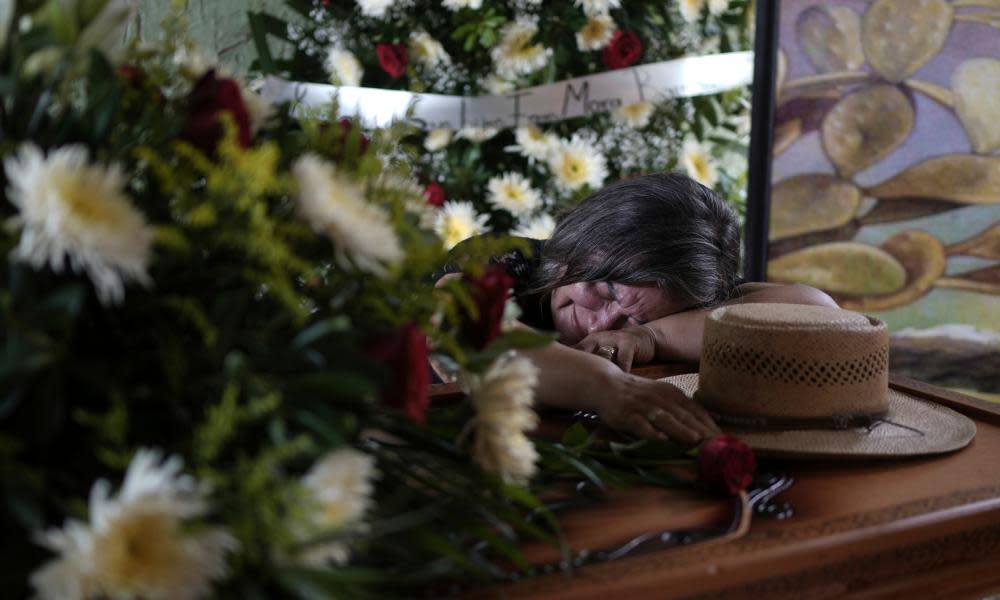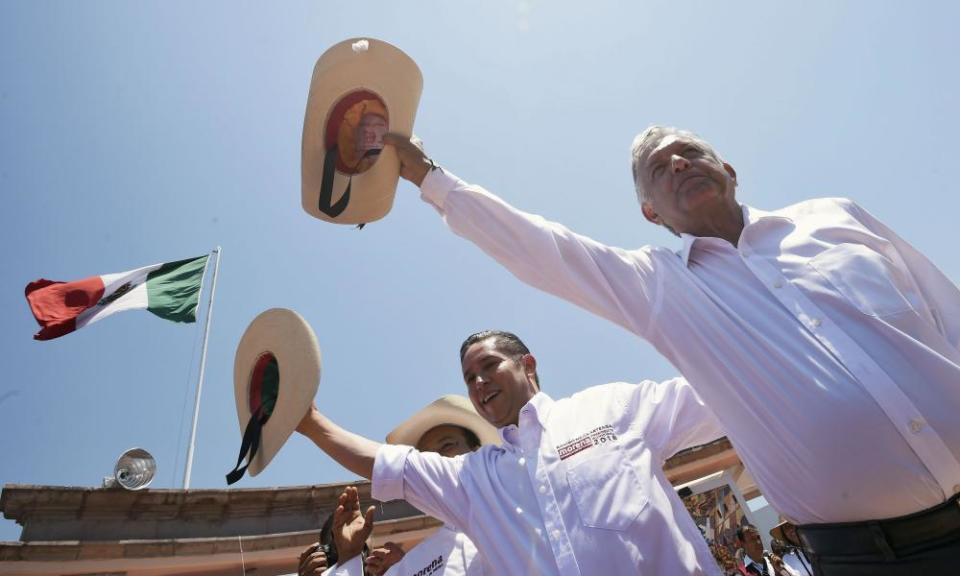Mexico vigilante leader’s killing highlights failure to curb violence

- Oops!Something went wrong.Please try again later.
- Oops!Something went wrong.Please try again later.
More than 150,000 people have been murdered since Mexico’s current president took power and Hipólito Mora suspected he would join them.
“I knew this day would come,” the lime farmer turned vigilante rebel wrote in a farewell message to be published in the event that it did.
Mora’s premonition was proved right on a recent afternoon, when he was killed in a blizzard of nearly 1,000 bullets in one of Mexico’s most violence-stricken states.
Related: Hipólito Mora, vigilante crusader against Mexico’s drug cartels, killed in ambush
Hours after Mora’s incinerated truck was towed from the crime scene, the 67-year-old’s trademark hat was placed on his coffin at a wake most people were too afraid to attend.
“We want justice. This cannot go unpunished,” his brother, Guadalupe Mora, said as he digested his sibling’s death foretold.
The murder of Mora – whose campaign against the cartels made him a national celebrity – has put the spotlight back on Mexico’s unfathomably brutal crime conflict, which claimed more than 30,000 lives last year.
President Andrés Manuel López Obrador won power in 2018 vowing to “pacify” his country with a dramatic, socially focused change in security policy he called “abrazos no balazos” – “hugs not bullets”.
“In three years’ time there will be no more war,” he told voters on the campaign trail.
But as López Obrador’s six-year term draws to a close and would-be successors jostle for position ahead of next June’s presidential election with Panglossian promises of their own, there is scant sign of peace.
Barely a day goes by without reports of bloodshed and ultra-violence in one of Mexico’s 31 states: a newspaper correspondent killed in Nayarit, eight call centre workers dismembered and six people killed in an IED attack on the police in Jalisco, a car bomb in Guanajuato, or the besieging of the state capital of Guerrero by thousands of protesters after two alleged gangsters were detained.
On 29 June, it was the shooting of Mora, one of the leaders of a 2013 civilian uprising against the Knights Templar cartel, that grabbed Mexican headlines.
Related: Mexico: IEDs kill four police officers and two civilians in ‘brutal’ cartel ambush
As the outspoken former vigilante travelled through the once tranquil rural community where he was born and raised, he was ambushed by two dozen gunmen and killed alongside three bodyguards.
Security expert Romain Le Cour said Mora’s assassination was partly a local story of a region plunged into bloodshed by collaboration between corrupt politicians and narco-traffickers who have long dominated the strategically positioned western state of Michoacán. The municipality where Mora died is reputedly Mexico’s most deadly for political and social activists.
But Le Cour said the murder also underlined how López Obrador’s “fairytale” campaign promises had failed to bear fruits.
The president took office promising a major rupture with the calamitous militarized “war on drugs” which began in Michoacán in 2006 under then president Felipe Calderón.
Calderón sends in the army
Mexico’s “war on drugs” began in late 2006 when the president at the time, Felipe Calderón, ordered thousands of troops on to the streets in response to an explosion of horrific violence in his native state of Michoacán.
Calderón hoped to smash the drug cartels with his heavily militarized onslaught but the approach was counter-productive and exacted a catastrophic human toll. As Mexico’s military went on the offensive, the body count skyrocketed to new heights and tens of thousands were forced from their homes, disappeared or killed.
Kingpin strategy
Simultaneously, Calderón also began pursuing the so-called “kingpin strategy” by which authorities sought to decapitate the cartels by targeting their leaders.
That policy resulted in some high-profile scalps – notably Arturo Beltrán Leyva, who was gunned down by Mexican marines in 2009 – but also did little to bring peace. In fact, many believe such tactics served only to pulverize the world of organized crime, creating even more violence as new, less predictable factions squabbled for their piece of the pie.
Under Calderón’s successor, Enrique Peña Nieto, the government’s rhetoric on crime softened as Mexico sought to shed its reputation as the headquarters of some the world’s most murderous mafia groups.
But Calderón’s policies largely survived, with authorities targeting prominent cartel leaders such as Sinaloa’s Joaquín “El Chapo” Guzmán.
When “El Chapo” was arrested in early 2016, Mexico’s president bragged: “Mission accomplished”. But the violence went on. By the time Peña Nieto left office in 2018, Mexico had suffered another record year of murders, with nearly 36,000 people slain.
"Hugs not bullets"
The leftwing populist Andrés Manuel López Obrador took power in December, promising a dramatic change in tactics. López Obrador, or Amlo, as most call him, vowed to attack the social roots of crime, offering vocational training to more than 2.3 million disadvantaged young people at risk of being ensnared by the cartels.
“It will be virtually impossible to achieve peace without justice and [social] welfare,” Amlo said, promising to slash the murder rate from an average of 89 killings per day with his “hugs not bullets” doctrine.
Amlo also pledged to chair daily 6am security meetings and create a 60,000 strong "National Guard". But those measures have yet to pay off, with the new security force is used mostly to hunt Central American migrants.
Mexico now suffers an average of about 96 murders a day.
As López Obrador, who most call Amlo, closed in on power there was talk of an ambitious overhaul of drug policy and even an amnesty for criminals designed to weaken the cartels fighting over smuggling routes to the US, as well as the local drug market and other money-spinners such as illegal mining and extortion.
Tackling root causes of crime such as poverty and unemployment was to be given priority over deadly crackdowns by security forces.
Le Cour said Amlo had fulfilled part of his promise with massive public spending on social programs – although a lack of government transparency made it impossible to gauge their effectiveness. But most pledges had fallen by the wayside, as the military was empowered rather than extracted from the fight against crime, and pledges of reform were forgotten.
“We were supposed to see a total strategic change that would go against the idea of a war against criminal groups and against militarization. What we have today is the status quo,” Le Cour said.
Related: Amlo promised to take Mexico’s army off the streets – but he made it more powerful
“Every day you have Amlo telling you: ‘The situation is improving. We’re not the same as previous governments … [But] I don’t think anyone really pays attention … because the situation is not improving.”
“[Hugs not bullets] was a very clever campaign slogan,” Le Cour added. But the “constant flow of incredible, insane, dramatic” outbreaks of violence made it clear it had not worked.
“I don’t want to sound too pessimistic but it’s hard today to find a glimpse of hope,” he said.
“In so many parts of Michoacán – and so many parts of Mexico – if you are a candidate, or a mayor, or an activist or a journalist, if you somehow touch or disrupt the equilibrium of the system, you are at risk of dying.”
Organized crime expert Guadalupe Correa-Cabrera agreed that Mexico found itself in “a very delicate position” as Amlo approached the final year of his term and it became obvious that bringing peace had been “an impossible mission”.

“The problem he inherited could never be resolved in so few years … I still can’t tell if it’s been worse than previous administrations – but it definitely hasn’t been any better,” she said.
Correa-Cabrera described Mora’s murder as symptomatic of a broader truth. “It appears organized crime has the ability to ... decide who lives and who doesn’t,” she said.
Last month, those groups decided Mora’s time had come, although quite why remains a mystery. The victim’s brother pointed the finger at two notorious local cartel bosses who have yet to be detained.
“If there’s no justice … we will have to get it ourselves [and] we, the people, will have to rise up in arms once again,” Guadalupe Mora vowed.
Related: Battle-scarred ghost town bears mute witness to Mexico’s drug wars
When the Guardian met Hipólito Mora in Michoacán last year he had just come back from lobbying top government officials in Mexico City over the security crisis. “We can no longer bear so much violence,” Mora remembered telling Mexico’s security chief, Rosa Icela Velázquez.
But he had no illusions the president would turn things around. “It’s incredible. Not even the beach is safe these days,” he said.
In his final WhatsApp message to the Guardian, a few months before his death, Mora forwarded a series of images picturing masked cartel gunmen who had commandeered a town in the mountains near his home.
“Just look at what they are doing in Mexico,” Mora wrote before signing off: “Saludos y abrazos” – greetings and hugs.
At 2.31pm on 29 June, his mobile phone went dead.

